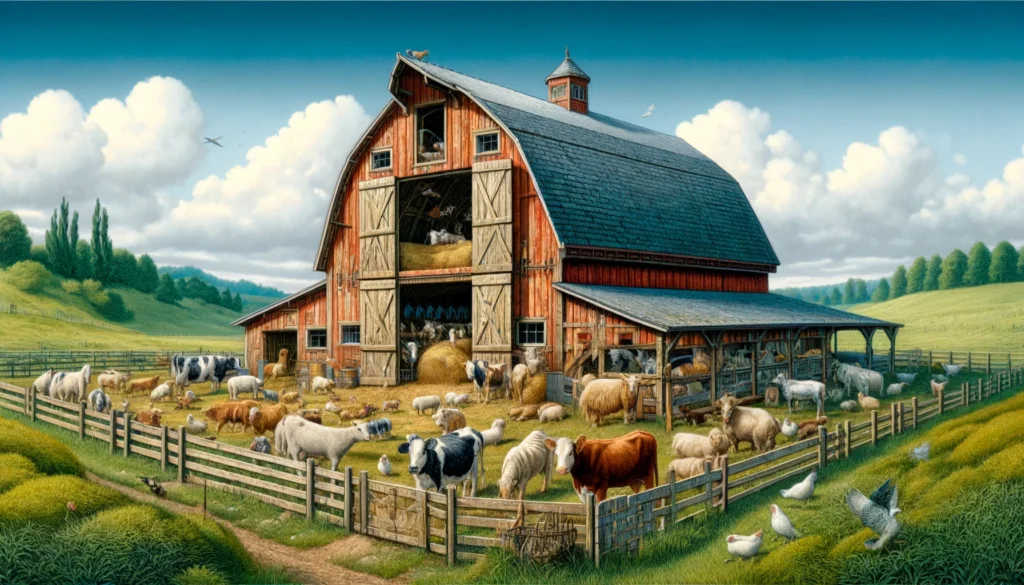
A rather serious barn for Livestock Housing A close up illustration of livestock housing on a farm depicted in a wide aspect. The scene shows a detailed vivid barn with various animals like co 1.webp.webp
Livestock Housing
Definition:
Livestock housing refers to the physical structures and facilities designed and constructed to provide shelter, protection, and comfort for animals raised in commercial farming operations, including beef cattle, dairy cows, pigs, poultry, sheep, and goats.
Insightful Analysis:
Livestock housing plays a crucial role in modern animal agriculture by providing a controlled environment that promotes animal health, welfare, and productivity, while also facilitating efficient management, feeding, and handling practices for farmers and producers.
Fall off the barn roof and busted your keister? Life on the farm or ranch can be tough on the bum. Need a break? Laugh it off at FarmerCowboy.com, the #1 farm humor site. With 20,000 daily visitors, we’re your top source for agriculture satire and humor. Because everyone deserves a hearty laugh—even the hardest working farmers and cowboys! Join us and turn those long days into fun tales at FarmerCowboy.com.
Guidance for Application:
1. Housing Design and Layout: Design and layout of livestock housing facilities should be optimized to meet the specific needs and requirements of different animal species, breeds, ages, and production stages. Factors to consider include space allowance, ventilation, lighting, temperature control, flooring, drainage, feeding and watering systems, and waste management.
2. Animal Welfare Considerations: Livestock housing should prioritize animal welfare by providing adequate space, comfort, and environmental enrichment to meet the behavioral, physiological, and social needs of animals. Housing design should minimize stress, injuries, and disease transmission, while promoting natural behaviors, such as resting, grooming, and social interaction.
3. Climate Control and Environmental Management: Livestock housing should incorporate climate control systems, such as fans, heaters, evaporative coolers, and ventilation systems, to regulate temperature, humidity, and air quality inside the facilities. Environmental management practices, such as manure management, odor control, and pest management, are also essential for maintaining a healthy and hygienic living environment for animals and workers.
4. Biosecurity and Disease Prevention: Livestock housing should implement biosecurity measures to prevent the introduction and spread of infectious diseases, parasites, and pathogens among animals and between farms. This may include restricted access, quarantine protocols, hygiene practices, vaccination programs, and sanitation procedures to minimize disease risks and protect animal health and productivity.
5. Worker Safety and Ergonomics: Livestock housing should prioritize worker safety and ergonomics by providing safe and ergonomic working conditions for farm workers and handlers. This may include proper lighting, non-slip flooring, ergonomic equipment, training programs, and personal protective equipment (PPE) to prevent accidents, injuries, and occupational hazards associated with animal handling and management tasks.
6. Sustainable and Efficient Operations: Livestock housing should promote sustainable and efficient farming practices by optimizing resource use, minimizing environmental impacts, and maximizing resource efficiency. This may involve incorporating renewable energy sources, water recycling systems, waste management technologies, and sustainable building materials to reduce energy consumption, greenhouse gas emissions, and ecological footprint.
7. Regulatory Compliance and Standards: Livestock housing should adhere to regulatory requirements, industry standards, and best management practices for animal housing, welfare, and environmental stewardship. Farmers and producers should stay informed about relevant regulations, codes of practice, and certification programs related to livestock housing, and ensure compliance with legal and ethical obligations.
Practical Recommendations for Livestock Producers:
- Assess your farm’s housing needs and priorities based on the type of livestock raised, production system, climate, and local regulations. Consider consulting with agricultural engineers, extension specialists, and industry experts to develop customized housing solutions tailored to your farm’s requirements and constraints.
- Invest in high-quality housing materials, equipment, and infrastructure that are durable, functional, and easy to maintain. Regularly inspect and maintain livestock housing facilities to identify and address potential hazards, defects, and structural weaknesses that could compromise animal welfare and productivity.
- Implement biosecurity protocols and hygiene practices to minimize disease risks and prevent the introduction and spread of infectious agents within your farm and between farms. This may include quarantine procedures, vaccination programs, biocontainment measures, and sanitation protocols to protect animal health and prevent disease outbreaks.
- Train farm workers and handlers in safe and responsible animal handling techniques, emergency procedures, and biosecurity protocols to minimize risks and ensure the health and safety of both animals and humans. Provide ongoing education and training opportunities to improve skills, knowledge, and awareness of best practices in livestock housing and management.
- Stay informed about emerging trends, technologies, and innovations in livestock housing and animal welfare, and explore opportunities for continuous improvement and optimization of your farm’s housing infrastructure and management practices.
In summary, livestock housing plays a critical role in supporting the health, welfare, and productivity of animals in commercial farming operations. By prioritizing animal welfare, environmental sustainability, worker safety, and regulatory compliance, livestock producers can create optimal housing environments that promote the well-being and resilience of their livestock while ensuring efficient and sustainable farming practices.
References:
- “Livestock Housing and Welfare.” World Animal Protection. Link
- “Livestock Housing and Facilities.” Penn State Extension. Link
- Grandin, T. (2015). Livestock Handling and Transport (4th ed.). CABI Publishing.



Originally posted 2012-10-17 21:17:27.
Originally posted 2024-06-26 12:12:22.
Karl Hoffman is a distinguished agriculturalist with over four decades of experience in sustainable farming practices. He holds a Ph.D. in Agronomy from Cornell University and has made significant contributions as a professor at Iowa State University. Hoffman’s groundbreaking research on integrated pest management and soil health has revolutionized modern agriculture. As a respected farm journalist, his column “Field Notes with Karl Hoffman” and his blog “The Modern Farmer” provide insightful, practical advice to a global audience. Hoffman’s work with the USDA and the United Nations FAO has enhanced food security worldwide. His awards include the USDA’s Distinguished Service Award and the World Food Prize, reflecting his profound impact on agriculture and sustainability.






